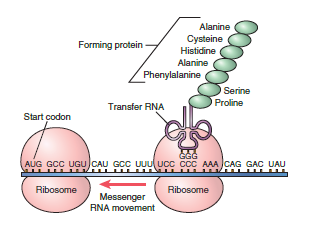
Genetic Control of Protein Synthesis, Cell Function, and Cell Reproduction
Proteins are macromolecules made up of monomers called amino acids. Different proteins are constructed by varying the types and numbers of amino acids used and by varying the order in which they are linked together. However, proteins are not built haphazardly, by randomly linking together amino acids. Every protein in the body is deliberately and precisely synthesized under the direction of the blueprint laid down in the person’s genome.Some of the cellular proteins are structural proteins, which, in association with various lipids and carbohydrates, form the structures of the various intracellular organelles. However, the majority of the proteins are enzymes that catalyze the different chemical reactions in the cells. For instance, enzymes promote all the oxidative reactions that supply energy to the cell, along with synthesis of all the cell chemicals, such as lipids, glycogen, and adenosine triphosphate (ATP).
At the end of the lesson, students will be able to understand;
GENES IN THE CELL NUCLEUS CONTROL PROTEIN SYNTHESIS
THE PROCESS OF TRANSCRIPTION
THE PROCESS OF TRANSLATION
GENETIC REGULATION
THE DNA–GENETIC SYSTEM CONTROLS CELL REPRODUCTION
CELL DIFFERENTIATION
APOPTOSIS—PROGRAMMED CELL DEATH
CANCER


